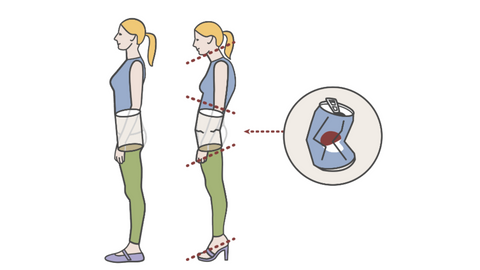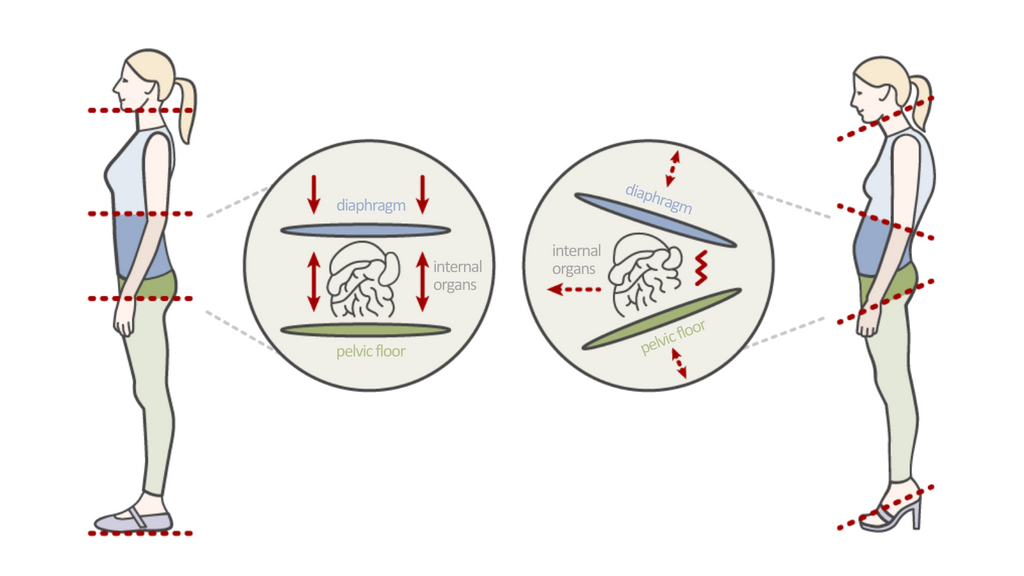Diastasis: What is it and how to deal with it? Walking and exercise will help
In this article, you’ll learn the following:
- What is diastasis?
- Who is affected by diastasis? It’s not just mothers
- Why is diastasis after childbirth so common?
- What are the symptoms of diastasis?
- Why does diastasis affect the whole body?
- How to do a home diastasis examination before seeing a physiotherapist?
- The same rules apply for both the prevention and treatment of diastasis
- Diastasis and flat feet: are they related?
-
Will barefoot shoes help?

You might be surprised at how much diastasis is related to the feet. We'll explain in a moment.
What is diastasis?
Diastasis is the distancing of the rectus abdominis muscles. When the ligament that connects them loosens, it causes the muscles to distance from each other – either along their entire length or only in part.
Simply put: Your abdomen has three layers of muscles. The top one stretches while the bottom ones protrude. Diastasis may or may not be visible at first glance.
Who is affected by diastasis? It's not just mothers
Diastasis is usually associated with pregnancy and motherhood. Around the 21st week of pregnancy, it affects 1 in 3 women, and up to 60% in the six-week postpartum period. But men or fitness enthusiasts can also be afflicted. It often occurs when you’re not using the correct technique while exercising or lifting weights.
Actively engaging the center of the body is important. People who have this part of their body weakened and inactive are more likely to have diastasis.
Why is diastasis after childbirth so common?
Three factors play a role:
- Hormones, which loosen ligaments.
- The growth of the baby, which presses on the mother's abdomen.
- A weakened center of the body, which may not have been evident before pregnancy.
The ligaments between the muscles loosen in pregnancy. The baby presses on them, and because the abdominal muscles weren’t active before pregnancy, they loosen and spread apart. New mothers see their belly bulging after giving birth and think it’s fat – in fact, however, it’s loose and separated muscles.
Diastasis associated with pregnancy usually disappears within a few weeks. If this hasn’t happened yet in your case or you’re not feeling well, see a physiotherapist as soon as possible.
Diastasis is also affected by the way you walk and stand in pregnancy. When you stand passively, your abdomen protrudes forward and your back arches – a good recipe for pain. Renowned physiotherapist Clara Lewit explains how to stand healthily in this video:
What are the symptoms of diastasis? From bulging abdomen to back pain
Is your belly bulging more than it used to, and yet your scale isn’t showing you the extra kilos? That's exactly what an abdomen with diastasis can look like, but not necessarily.
What’s more serious than the shape of the abdomen, however, is the fact that the abdominal muscles are not fulfilling their proper function. Everything in the body is interconnected – and the abdominal muscles are team players. Along with the back muscles, diaphragm and pelvic floor, they keep the torso erect and carry the organs.

The human body is like a tower of blocks. When you move the individual blocks, it loses stability.
When the abdominal muscles loosen up, a greater load is put on the back muscles, causing them to be overworked and painful. This creates uneven tension that spreads throughout the body, and it can manifest itself in unexpected ways, like neck pain or headaches.
A greater load is also shifted to the spine. Therefore, diastasis can also lead to blockages or prolapses.
The most common manifestations of diastasis include:
- a bulging abdomen
- back and lumbar pain
- pain in the cervical spine
- headaches
- hip pain
- a dysfunctional pelvic floor and related problems
Diastasis may not be visible at first glance. That’s why you should see a physiotherapist if you’re experiencing any of the problems we’ve mentioned above.
Why does diastasis affect the whole body? Because we're built like tin cans
Imagine your torso as a tin soda can. The bottom is the pelvic floor, the lid is the diaphragm, and the walls are the abdominal and back muscles. The walls of the tin can aren’t very strong, yet you can stand up on one and it’ll carry your weight.
But what happens if you dent the wall of the can, even a just a little? Just apply a bit of pressure from the top down and the whole can will crumple.
The human body works in a similar way, and these abdominal muscles are an important part of the wall of our "tin can". When the wall doesn’t work correctly, the can deforms.
Dysfunctional abdominal muscles cause overburdened backs, poor tension of the pelvic floor and diaphragm, and difficulties throughout the system.

When you tilt the pelvic floor, it creates imbalance and tension. It's as if you were to deform an empty can.
How to do a home diastasis examination before seeing a physiotherapist
So your physiotherapist appointment is still a month away and you’d like to know if diastasis is afflicting you? How do you find out?
- Lie down on the floor on your back.
- Bend your legs at the knee and place your feet on the floor.
- Raise your head and breathe freely.
- Run your hand over the center line of the abdomen – from the sternum over the navel and down to the pelvis.
-
Continue until the exercise becomes difficult and you need to put your head back down.
Did you feel firmer muscles and soft tissue between them? This may indicate diastasis.
You can try the same test along the whole line stretching from the sternum over the navel and down to the pelvis.
The same rules apply for both the prevention and treatment of diastasis
How can you get rid of diastasis and how do you prevent it? The principle is simple. Just strengthening the abdominal muscles isn’t enough; you have to activate the center of the body and get rid of everything that’s harming it.
Let's look at the basic rules of prevention and treatment.
1. Get rid of everything that's binding you
When you’re restricting and binding your body, it seeks methods of functioning that are unnatural. It overloads some muscles while shutting down others. So start by eliminating overly constricting bras or corsets. Tight belts or constricting underwear aren’t doing you any good either.
2. Wear healthy shoes
Stability and proper tension in the body start with the feet. When the feet are actively carrying you, correct tension is spread through the legs and pelvis and into the abdominal muscles. In contrast, shoes with heels or narrow tips change your posture, causing your back to arch and your abdomen to protrude.

Did you know that heels change your posture? They do, and unfortunately not in a good way.
To prevent diastasis, get rid of the following if it’s in your shoe collection:
- heeled or platform shoes
- narrow, constrictive shoes
- any footwear that restricts your feet
Ideal footwear is footwear that respects the natural shape and function of the foot – this typically means anatomically shaped barefoot shoes. We'll take a look at those below.
Reading tip: How to choose healthy shoes in pregnancy? A physiotherapist gives advice.
3. Practice correct standing and sitting
An upright posture is the most natural position for us humans. When we stand upright, the center of the body is active, keeping the torso erect, i.e. “carrying” it. But most of us stand with our backs arched and our heads forward. With that kind of posture, the abdomen "bulges" forward, the abdominal muscles don’t work, and the back becomes overloaded.
The same applies to sitting. If, like most people, you slouch in your chair, you’re overloading your back and not engaging your abdomen at all.

While standing up, pay attention to your feet and pelvic floor – they should remain active throughout the movement.
Assuming the correct posture isn’t enough. As soon as you stop paying attention to it, you’ll return to your original position. That’s why you need to establish the right conditions first – a healthy workspace, anatomical shoes. Then learn to use your feet actively. The e-book Step by Step to a Healthy Stride (free download) will help you do this.
If you spend a lot of time sitting, don't forget to take breaks. Get up every half hour, walk around and stretch.
4. Walk – preferably barefoot
There’s no movement more natural than walking. When you walk healthily, your posture will straighten, activating the center of your body – including your weakened abdomen. But be careful – not all walking is the same.
Since we were little, we’ve been binding our feet in shoes. That's why we’ve grown accustomed to walking in a different way than nature intended – slouching, with passive feet. To get the full benefit of walking, take off your shoes and start to sense your feet.
Once you free your feet and learn to walk healthily, your body will naturally straighten. As physiotherapist Marika Bajerová says: "When you activate the supportive function of the feet, the pelvic muscles are activated and the uterus is centered in the abdomen."
Reading tip: 7 Good Reasons to Go Barefoot During Pregnancy

When it's too cold to walk barefoot, walk in shoes that simulate barefoot walking.
5. Learn to breathe
Think everyone knows how to breathe? Think again! We often breathe superficially, and by doing so we’re depriving ourselves of a score of benefits. Take a yoga class and learn to breathe fully. While practicing yoga, you’ll be breathing into the abdomen and ribs and all the way down below the collarbones. This creates a breath wave that stimulates the diaphragm, internal organs and abdominal muscles.
6. Exercise, but don't do sit-ups
"If we exercise every day but keep wearing heels and slouching, diastasis will come back," says physiotherapist Lukáš Klimpera.
Even the greatest fitness enthusiasts can’t reverse diastasis by exercising if they don’t have an active center of the body and they aren’t giving the body what it needs. That’s why you should first focus on the previous recommendations above. Only once you’re following them will the exercises work.
Your physiotherapist will recommend the right exercises for you based on your condition. But we have one bit of advice here: Don't rely on gym exercises. Crunches or sit-ups may work to strengthen the abdominal muscles, but they often overload them and don't activate the center of the body. Yoga exercises or Tai Chi are more suitable, as they’ll teach you how to sense your own body and exercise according to its capabilities.
You can try this exercise at home:
- Lie down on your back.
- Place both hands palm down on your abdomen and gently feel its tension.
- Try laughing out loud or coughing and try to sense what part is being activated and how.
- Try to keep this tension under your hands for a while. Breathe freely, not forcefully.
Once you’ve learned this in a lying down position, you can start practicing while sitting or standing.
Diastasis and flat feet: Are they related?
Yes, they may be related. Flat feet are usually an indication of inactive foot arch muscles, which don’t allow your legs to actively carry you. And your body posture changes – you arch your back and stick out your abdomen, which weakens. You already know the rest: When the abdomen is inactive, there's a risk of diastasis.
"If our legs aren’t actively carrying us, there’s no proper tension in the diaphragm, pelvic floor and deep abdominal muscles," says physiotherapist Lukáš Klimpera.
That’s why you can solve both problems at the same time. How?
- Wear only shoes that don’t restrict you. Unsuitable shoes are often the reason that the muscles of the feet weaken. That’s why you should focus on shoes with a wide toe box that respect the shape of the foot.
- Go back to basics and practice healthy walking. The e-book Step by Step to a Healthy Stride will help.
- Whenever you can, walk barefoot. This will stimulate your feet and teach you to step sensitively.
With active feet, you’ll start to see changes in your abdomen. When walking healthily, you’re straightening your posture and naturally activating your deep abdominal muscles. You'll awaken the center of your body and begin to gently strengthen it, thus getting perfect physiotherapy with every step.

We ourselves are often the cause of our flat feet – by wearing the wrong shoes. Look for spacious and healthy shoes like these.
Will barefoot shoes help? Yes, but be careful of how they’re shaped
If walking barefoot helps with diastasis, will walking in barefoot shoes help? Yes, but...
The effect of barefoot footwear on diastasis is similar to that of walking barefoot. But be careful about which barefoot shoes you’re buying. You won't recognize a healthy barefoot shoe only because it has a thin sole. The following parameters are even more important:
- A wide toe box that provides room for your toes.
- Flexible materials that adapt and don’t constrict.
- A flexible sole that copies the movement of the foot.
Reading tip: 13 myths about barefoot shoes. Why aren't they just "thin-soled shoes"?
Ahinsa shoes were designed by physiotherapists – that’s why you can be sure you’re putting on a pair of healthy shoes. For barefoot beginners, we also have the Comfort line, which will soften your steps. Wear healthy shoes!





















